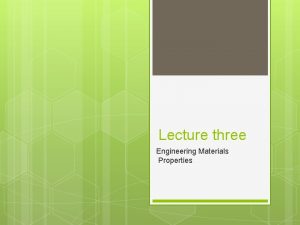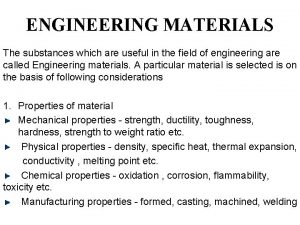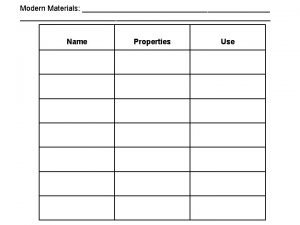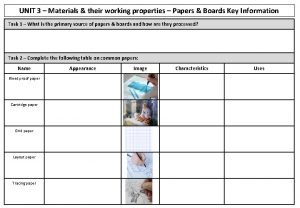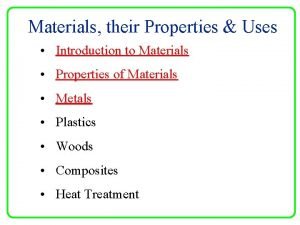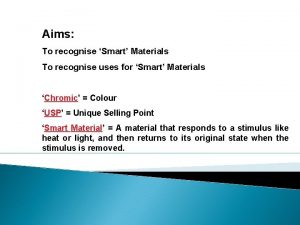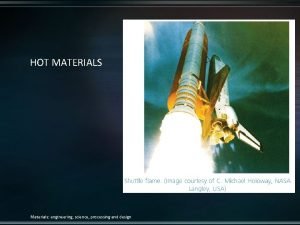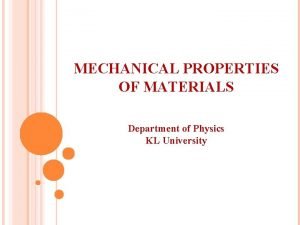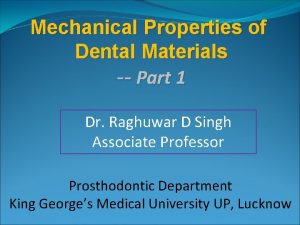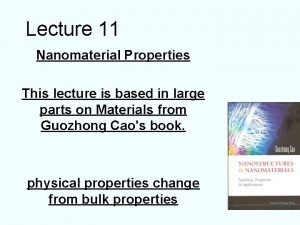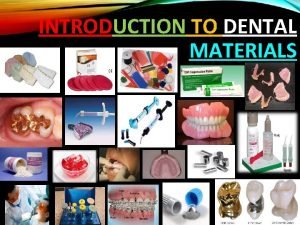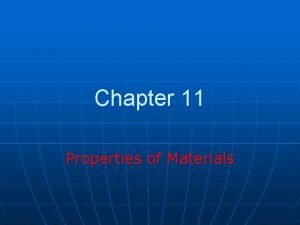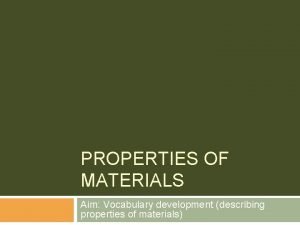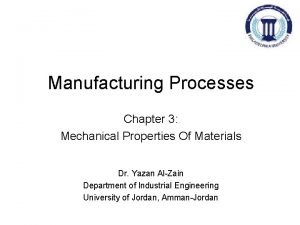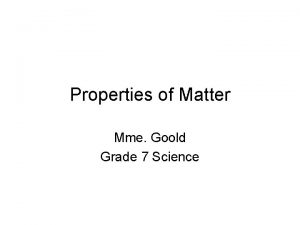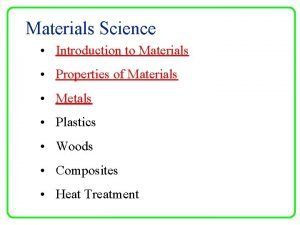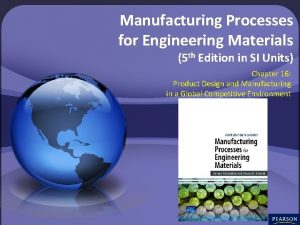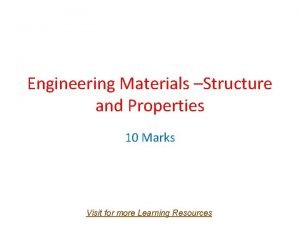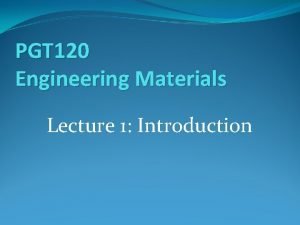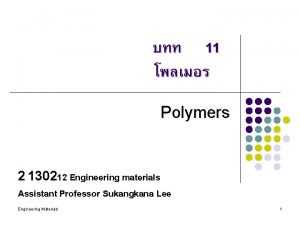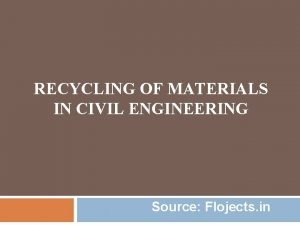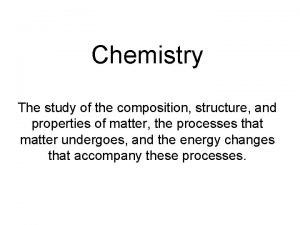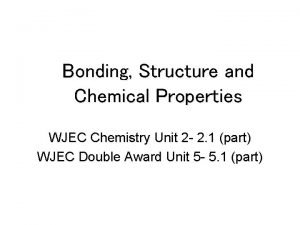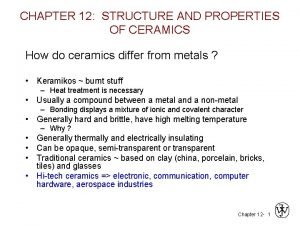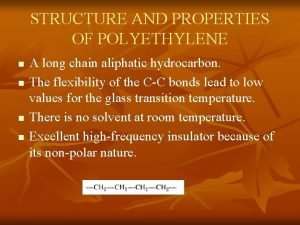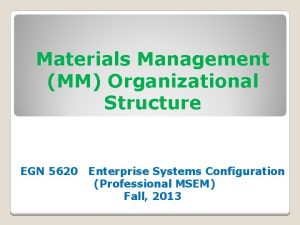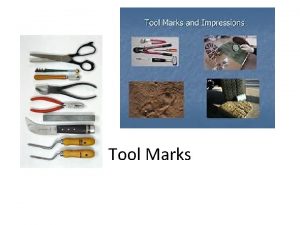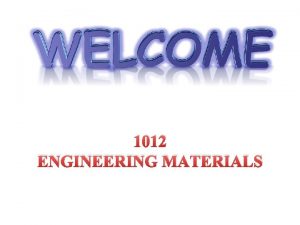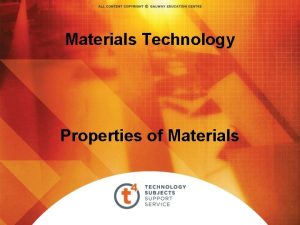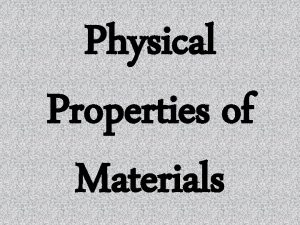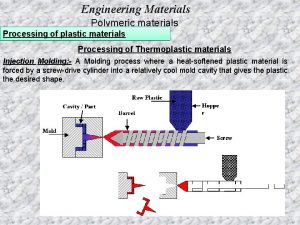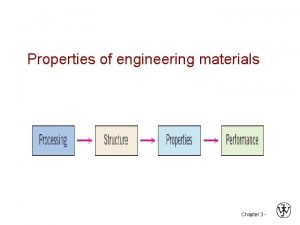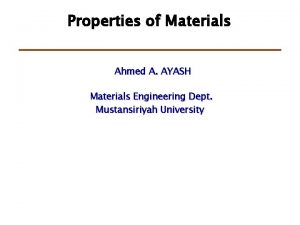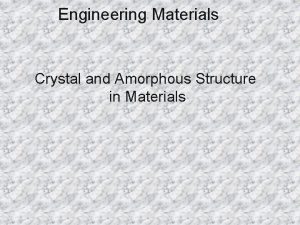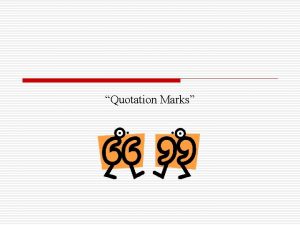Engineering Materials Structure and Properties 10 Marks Visit





















































- Slides: 53

Engineering Materials –Structure and Properties 10 Marks Visit for more Learning Resources

Co related to chapter • Identify crystal structure and properties of material.

Types of Engineering Materials Broadly Engineering Materials are classified as: Engineering Materials Polymers Metals &Alloys Composites Ceramics Thermoplastic. Pol Thermosetting. Poly Elastomers ymers mer

METAL • A solid material which is typically hard, shiny, malleable, fusible, and ductile, with good electrical and thermal conductivity • (e. g. iron, gold, silver, and aluminum, and alloys such as steel)

ALLOY • An alloy is a material composed of two or more metals or a metal and a nonmetal.

Types of Engineering Materials Metals & Alloys are futher classified as: Metals & Alloys Ferrous Non-ferrous Cu-Alloys Al-Alloys Steels Cast Irons Ni-Alloys Plain Carbon Steels Alloy Steels White Cast Iron Malleable Cast Iron Grey Cast Iron S. G. Cast Iron Chilled Cast Iron

• Ferrous: iron as main constitute • Non ferrous: other than iron as main constitute. • Steel: carbon less than 2 %. • Cast iron: carbon more than 2%. • Cu alloy: cu as main content. • Al alloy: Al as main content. • Ni alloy: Ni as main content.

POLYMER • The word polymer means • Poly means many and meros means units, parts. • Polymer means many parts or many units

THERMOPLASTIC POLYMER • A thermoplastic, or thermosoftening plastic, is a plastic material, polymer, that becomes pliable or moldable above a specific temp and solidifies upon cooling. • thermoplastics may be reshaped by heating Temperature and solidifies upon cooling.

Thermosetting polymers • Thermosetting polymers have their chains cross linked by covalent bonds. • The starting materials are placed into a mould to form the desired shape. • The polymer is then heated (or initiated with uv light) and chemical reactions occur to form the cross links between the chains. • The resulting three dimensional solid structure cannot then be changed. • Further heating will not cause the polymer to soften, melt or change shape (unlike thermosoftening polymers).

Thermosetting polymers • The picture below shows a typical structure for a thermosetting polymer. The red lines represent the cross links between the chains.

Examples • Epoxy resins - used as coating materials, caulks, manufacture of insulating materials, etc. . . • Phenolic resins - tool handles, billiard balls, sprockets, insulation, etc. . . • Unsaturated polyester resins - manufacture of plastics reinforced fiberglass commonly known as polyester, fillers, etc. . .

Elastomers • Elastomer materials are those materials that are made of polymers that are joined by chemical bonds, acquiring a final slightly crosslinked structure.

• Natural rubber - material used in the manufacture of gaskets, shoe heels. . . • Polyurethanes - Polyurethanes are used in the textile industry for the manufacture of elastic clothing such as lycra, also used as foam, wheels, etc. . . • Polybutadiene - elastomer material used on the wheels or tires of vehicles, given the extraordinary wear resistance. • Neoprene - Material used primarily in the manufacture of wetsuits is also used as wire insulation, industrial belts, etc. . . • Silicone - Material used in a wide range of materials and areas due their excellent thermal and chemical resistance, silicones are used in the manufacture of pacifiers, medical prostheses, lubricants, mold, etc. . .


Composite • Composite materials (also called composition materials or shortened to composites) are materials made from two or more constituent materials with significantly different physical or chemical properties, that when combined, produce a material with characteristics different from the individual components.

Material used in the Boeing 787

Types of Engineering Materials Composites are futher classified as: Composites Laminar Particle Reinforced Fibre Reinforced

Types of Engineering Materials Ceramics are futher classified as: Ceramics Metal Oxides Nitrides Carbides Alumina Beryllia Zirconia Glass Ceramics Ceramic s defined as any inorganic (inorganic substances do not contain carbon or its compounds)non metallic material.


Amorphous material • The material have no regular arrangement of their molecules. • Material like glass and paraffin are example of amorphous material. • These material have properties of solids. • They have definite volume and shape and diffuse slowly.

• Amorphous carbon

Crystalline material • In a crystalline structure , the atoms are arranged in three dimensional array called a lattice. • The lattice has a regular repeating configuration in all direction.

polymorphism • A crystal is defined as an orderly array of atoms in space. • Normally metals are made up of number of crystals and each crystal consist of large number of atoms. • Crystal structure is atomic arrangement in solids. • Polymorphism is the ability of solid material to exist in more than one form or crystal structure.


Single atom Unit Cell lattice

Crystal Structure in Metals Majority of Metals falls in either of the following crystal structure Ø BCC (Body Centered Cubic) Ø FCC (Face Centered Cubic) Ø HCP (Hexagonal Close Packed)

Crystal Structure in Metals BCC (Body Centered Cubic) Examples: α-iron, Mo, W, V, Ta, Cr, Na, K

Crystal Structure in Metals BCC (Body Centered Cubic)

BCC (Body Centered Cubic) In these structure, there are 8 corner atoms and one atom at in the interior i. e. in the centre of the unit cell with no atom on face. Therefore, Nav = average no. of atoms per unit cell. Nc= total no. of corner atom in unit cell. Nf= total no. of face atom in unit cell. Ni = center or interior atom Nc = 8, Nf=0, Ni=1 Nav= (Nc/8)+(Nf/2)+(Ni/1) =(8/8)+(0/2)+(1/1) =2

Crystal Structure in Metals Ø FCC (Face Centered Cubic) Examples: γ-iron, Cu, Ag, Al, Pb, Ni, Pt

Crystal Structure in Metals Ø FCC (Face Centered Cubic)

FCC (Face Centered Cubic) In these structure, there are 8 corner atoms and 6 atoms at centre of the face and interior atom Therefore, Nav = average no. of atoms per unit cell. Nc= total no. of corner atom in unit cell. Nf= total no. of face atom in unit cell. Ni = center or interior atom Nc = 8, Nf=6, Ni=0 Nav= (Nc/8)+(Nf/2)+(Ni/1) =(8/8)+(6/2)+(0/1) =4

Crystal Structure in Metals Ø HCP (Hexagonal Close Packed) Examples: Mg, Zn, Be, Cd, Co, Zr, Ti

HCP (Hexagonal Close Packed) • For hexagonal structure, the corner atoms are shared by 6 cells (3 from below and 3 from above), face atoms are shared by adjacent 2 cells, and atoms in the interior are shared by only one cell. • Nav= (Nc/6)+(Nf/2)+(Ni/1) • For HCP structure , there are 12 corner atoms, 2 atoms at the centers of the above two faces and 3 atoms in the interior of the unit cell.

HCP (Hexagonal Close Packed) • Nc = 12, Nf=2, Ni=3 • Nav= (Nc/8)+(Nf/2)+(Ni/1) • =(12/6)+(2/2)+(3/1) • =6

Physical properties • Density of a substance is its mass per unit volume. • The symbol most often used for density is ρ (the lower case Greek letter rho). • Mathematically, density is defined as mass divided by volume. • where ρ is the density, m is the mass, and V is the volume.

Density

Melting point • The melting point of a solid is the temperature at which it changes state from solid to liquid at atmospheric pressure. • The melting point of a substance depends (usually slightly) on pressure and is usually specified at standard pressure. • The melting point of ice at 1 atmosphere of pressure is very close to 0 °C (32 °F, 273. 15 K).


Specific heat • Energy required to change the temperature of an object by 1 degree c. • The SI unit of heat capacity is joule per kelvin. • Metals have lower specific heat capacity than plastics. • Therefore they require less heat to reach a particular temperature than plastics.

Thermal expansion • Thermal expansion is the tendency of matter to change in volume in response to a change in temperature, through heat transfer. • The degree of expansion divided by the change in temperature is called the material's coefficient of thermal expansion and generally varies with temperature. • (lf-l 0) / l 0 = � 1 (Tf-To) • Where, lf and lo are initial and final length. • Tf and T 0 are initial and final temperature. • � 1 is coefficient of thermal expansion. • Unit is reciprocal temperature i. e. 1/c°


Thermal conductivity • It is the property of a material to conduct heat. • often denoted k, λ, or κ. • In SI units, thermal conductivity is measured in watts per meter kelvin (W/(m·K)) • High energy generation rates within electronics or turbines require the use of materials with high thermal conductivity such as copper (see: Copper in heat exchangers), aluminium, and silver. • On the other hand, materials with low thermal conductance, such as polystyrene and alumina, are use in building construction or in furnaces in an effort to slow the flow of heat, i. e. for insulation purposes


Mechanical properties • Strain • Change in dimension per unit original dimension is nothing but strain. • Stress • Applied force per unit area is nothing but stress. • σ= F/A. • N/mm 2.

• Strength • Ability of a material to resist the externally applied force without breaking or yielding. • Stiffness • It is ability of material to resist deformation under stress. • Elasticity • It is property of material to regain its original shape after deformation when the external force are removed. • Steel is more elastic than rubber. • Plasticity • It is property of a material which retains the deformation produced under load permanently.

• Ductility • It is ability of a material enabling it to be drawn in to wire with the application of a tensile force. • Steel copper aluminium nickel zinc lead tin • Brittleness • It is property of a material opposite to ductility. • It is the property of breaking of material with little permanent distortion. • Cast iron is a brittle material • Malleability • It is special case of ductility which permits materials to be rolled or hammered in to thin sheets. • Lead soft steel wrought iron copper aluminium.

• Toughness • It is property of material to resist fracture due to high impact load like hammer blow. • Machinability • It is property of a material which refers to relative case with which a material can cut. • Resilience • It is property of a material to absorb energy and resist shock and impact load. • Creep • When a part is subjected to a constant stress at high temperature for long period of time, it will under go slow and permanent deformation called creep.

• Fatigue • When a material is subjected to a repeated stresses, it fails at a stresses below the yield point stresses. Such type of failure of material is called fatigue. • Hardness • Resistance to wear, scratching, deformation and machinability. • It also mean ability of material to cut another metal.

Packing efficiency • The packing efficiency is the fraction of crystal occupied by the atoms. • It must be always less than 100%. Because it is impossible to pack spheres without empty space between them. • Packing efficiency is the percentage of total space filled by the particles. • It is also called as atomic packing factor. • (Volume occupied by atoms in unit cell/ total volume of unit cell ) x 100

Packing efficiency for Bcc structure

For more detail contact us
 Speech marks and exclamation marks
Speech marks and exclamation marks Optical properties of engineering materials
Optical properties of engineering materials What is the engineering materials
What is the engineering materials Cant stop the feeling go noodle
Cant stop the feeling go noodle Useful but harmful materials
Useful but harmful materials Man made map
Man made map Adopting and adapting teaching materials
Adopting and adapting teaching materials Thermophysical properties of dental materials
Thermophysical properties of dental materials Properties of modern materials
Properties of modern materials Materials and their working properties
Materials and their working properties Materials properties and uses
Materials properties and uses Natural science grade 7 notes
Natural science grade 7 notes Difference between smart and modern materials
Difference between smart and modern materials Direct materials budget with multiple materials
Direct materials budget with multiple materials Materials: engineering, science, processing and design
Materials: engineering, science, processing and design Dmse iit delhi
Dmse iit delhi Descriptive matter
Descriptive matter Chemical property of water
Chemical property of water Lateral strain
Lateral strain Flexibility in dental materials
Flexibility in dental materials Hardness of nanomaterials
Hardness of nanomaterials Ideal requirements of restorative material
Ideal requirements of restorative material Properties of materials examples
Properties of materials examples Properties of materials vocabulary
Properties of materials vocabulary Manufacturing properties of materials
Manufacturing properties of materials Manufacturing properties of materials
Manufacturing properties of materials What is matter in science grade 7
What is matter in science grade 7 Matter and materials grade 7
Matter and materials grade 7 Properties of materials examples
Properties of materials examples 5 properties of materials
5 properties of materials Manufacturing processes for engineering materials
Manufacturing processes for engineering materials Heat conductivity examples
Heat conductivity examples What is the engineering materials
What is the engineering materials Engineering materials
Engineering materials Materials for engineering
Materials for engineering Integrated computational materials engineering
Integrated computational materials engineering Integrated computational materials engineering
Integrated computational materials engineering Floject
Floject Forward engineering and reverse engineering
Forward engineering and reverse engineering Rizal participated in the student demonstration in madrid
Rizal participated in the student demonstration in madrid Margo and her parents visit each other often
Margo and her parents visit each other often What is bernard marx's job
What is bernard marx's job Marks and spencer strengths and weaknesses
Marks and spencer strengths and weaknesses Atomic structure and properties ap chemistry
Atomic structure and properties ap chemistry The study of composition structure and properties
The study of composition structure and properties Bonding structure and properties wjec
Bonding structure and properties wjec Structures and properties of ceramics
Structures and properties of ceramics Polyethylene structure and properties
Polyethylene structure and properties Emergent system properties in software engineering
Emergent system properties in software engineering Reciprocal network
Reciprocal network Concrete surface prep standards
Concrete surface prep standards Materials management organizational structure
Materials management organizational structure The distinct threadlike structures that contain the genetic
The distinct threadlike structures that contain the genetic A saclike structure in which cells store materials
A saclike structure in which cells store materials

